Your prospects and customers care about one thing: does your product actually solve their problems?
When you can't show this clearly, prospects lose interest and customers leave for competitors who can. Traditional demos fail because they're generic product tours, not problem-solving experiences.
Interactive demos fix this by letting prospects explore exactly how your product handles their specific situation. Instead of watching you click through features, they click through their own workflow and see it solve their challenges.
But here's the problem with the current market: Every vendor claims their interactive demo tool is revolutionary. Some can barely handle basic screen recordings. Others charge enterprise prices for glorified GIF makers. A few actually deliver tools that help you create demos people want to engage with.
To help you cut through the noise and choose the platform that suits your needs, we've evaluated the top 10 interactive demo platforms to find the ones that deliver real value for your investment.
What is interactive demo software, and why should you use it?
Interactive demo software enables you to create clickable, engaging product walkthroughs that don't require users to sign up for your actual product. It's like a "try before you buy" experience that captures your product's essence in a risk-free environment.
Unlike regular presentations or videos, interactive demos put prospects in the driver's seat. They can click buttons, navigate menus, and see real results, which helps them understand your product faster than any explanation could.
Whether you're qualifying leads, closing deals, or onboarding new customers, interactive demo software helps you:
- Break down complex features intuitively
- Tap into the pain points and show exactly how your product solves it
- Highlight your product’s ‘aha moments’
Top 10 interactive demo tools in 2025
We've handpicked the 10 best demo tools with features, pros, cons, and pricing for you to evaluate and choose the one right for your team.
If you’re running less on time and want a quick glimpse of each tool, refer to the comparison table below:
| Interactive demo tool | Key features | Pricing |
HTML/Sandbox demos, AI voiceovers & translations, Multi-demo showcases, Demo analytics, Personalized trackable links, In-app product tours, Customizable interactive elements, Multiple sharing options, Integrations (HubSpot, Salesforce, Slack, Zapier) | Free: $0 (5 demos) Pro: $27/month per seat Scale: $38/month per seat Enterprise: Custom pricing | |
Navattic | HTML/CSS capture, Offline demos, Multiple embedding options, Proactive suggestions | Starts from $500/month |
Arcade | AI Voiceovers, Record camera and screen, Page morph | Starts from $38/month |
Walnut.io | AI-powered content enhancement, Multi-platform integration, Demo wizard | Starts from $9,200/year |
Storylane | HTML capture, Demo hub collections, Lily AI assistant | Starts from $40/month |
Tourial | AI-driven demo creation, Micro Tours, Customizable branding | Starts from $600/month |
Demoboost | Dual demo modes, Internal collaboration tools, Auto-translation capabilities | Custom pricing |
Consensus | Product simulations, Demolytics, BuyerBoard | Custom pricing |
Reprise | Reprise Replay/Reveal, Full HTML/CSS control, Plugin library | Custom pricing |
Demostack | Product cloning technology, Cross-platform demo environments, Demo Playbooks | Starts from $50,000/year |
1. Supademo
Supademo is a no-code interactive demo platform purpose-built for sales, marketing, customer success, and product teams to create engaging product demos. Teams can showcase software features and functionality to prospects, customers, and internal stakeholders using Supademo's Chrome extension, desktop app, or mobile recording capabilities.
Whether you're a startup looking to quickly demonstrate product value, an SMB scaling your sales process, or an enterprise needing demos across multiple teams, Supademo provides the tools to create interactive product demos at scale.
What are the best features of Supademo?
- Create HTML and Sandbox demos: Supademo lets you create pixel-perfect HTML and CSS copies of your product where viewers can click through and interact with each element exactly like the real application.
- AI assistance: Supademo users get automated hotspot text generation, AI voiceovers with multiple tones and accents, and instant translations into 15+ languages to speed up demo creation and distribution.
- Multi-demo showcases: Supademo allows you to create collections for sharing related Supademos through one URL or embed, organizing demos by use cases for easier workflow and better collaboration across teams
- Demo analytics: You get detailed engagement metrics including completion rates, session data, average engagement percentage, leads captured, and session durations directly within viewer profiles
- Personalized trackable links: Users can create unique URLs for each viewer from one demo, enabling individual tracking without creating separate demos for each prospect or customer
- In-app product tours: This feature allows you to trigger any Supademo or Showcase as an overlay on top of your product experience – helping you highlight new features, product tutorials, or onboarding guides in-context.
- Customizable interactive elements: You can edit demos with personalized chapters, hotspots, variables, branching, autoplay options, and choose to show hotspots always visible or only on hover, with invisible hotspots available for HTML-based demos to map sections without visible cues.
- Multiple sharing options: You can share demos as links or embed them in knowledge bases, websites, support docs, and onboarding playbooks, plus export demos as videos, GIFs, or SOP formats for use across different platforms
- Integrations: Supademo connects natively with HubSpot, Salesforce, and Slack to sync viewer engagement data, plus integrates with thousands of apps through Zapier for automated workflows.
What are the pros and cons of Supademo?
✅Free signup - Users can start using the platform immediately without providing payment information or financial commitments
✅Easy onboarding and setup - Users can join the platform and immediately start creating demos without any technical expertise or complicated setup processes
✅High-quality AI voiceovers - Users say the AI-generated voiceovers as being some of the most human-sounding and least robotic they have experienced.
✅Professional output quality - Platform enables users to produce professional-looking demos and standard operating procedures that maintain high visual standards
✅Showcase functionality - Users love the ability to create "playlists" of multiple demos, allowing customers to pick and choose which specific features they want to explore
✅Responsive customer service - Users report that they consistently receive immediate, helpful support.
❌Limited integrations - Options are currently limited to major platforms (HubSpot, Salesforce, Marketo, Zapier, Google Analytics, Slack)
What is Supademo’s pricing?
- Free: $0 with 5 demos
- Free trial: 14-day
- Pro team: $27/month per seat
- Scale: $38/month per seat
- Enterprise: Contact us to get a quote
2. Navattic
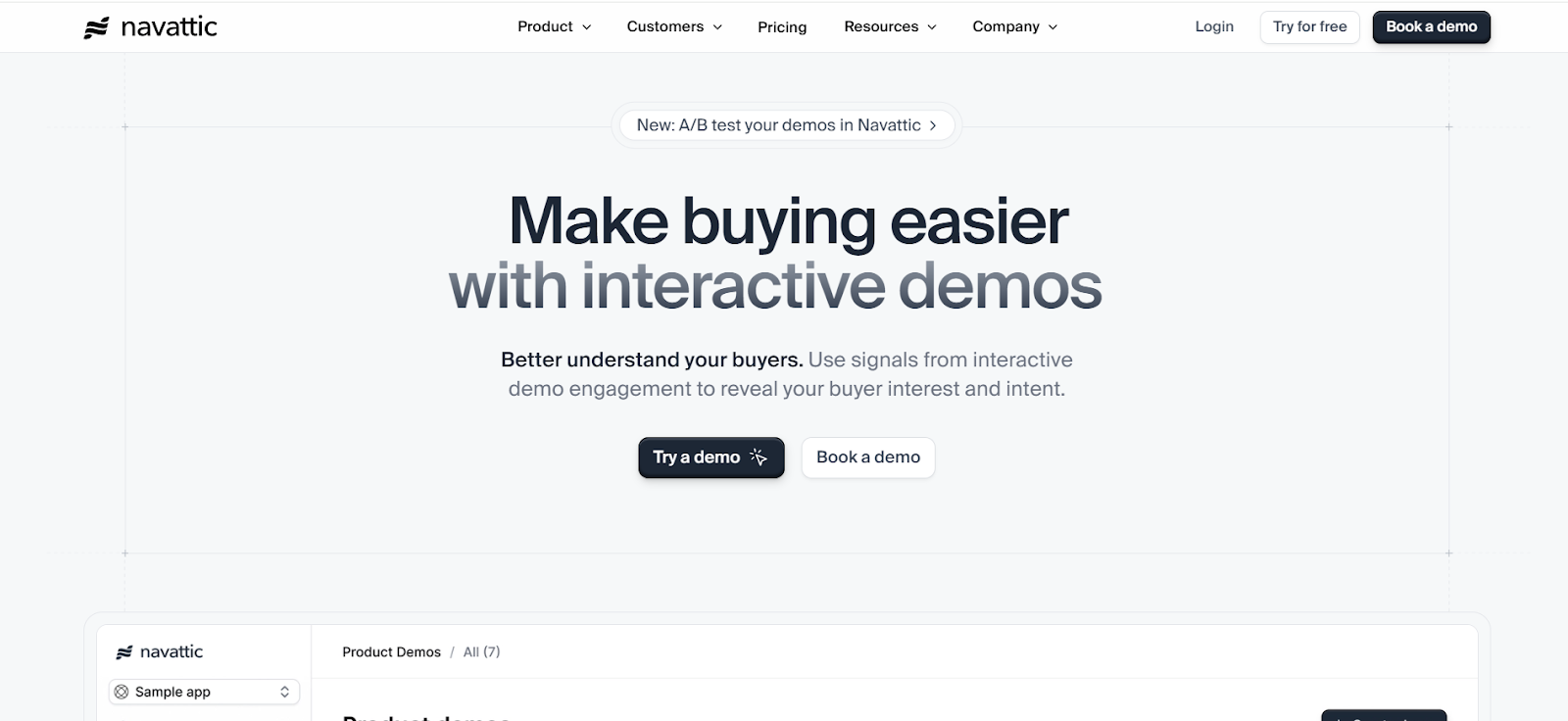
Navattic is an interactive demo platform that captures your product's HTML and CSS to create clickable, guided tours without coding. Designed for B2B SaaS marketing and sales teams, it enables prospects to experience products hands-on before purchase.
What are the best features of Navattic?
- Multiple embedding options: Navattic demos can be easily embedded on websites, used in email campaigns, or shared via links, with diverse embed options including inline, full page, or pop-up code for website embeds.
- Offline demos: Creators can download interactive demos to present them without an internet connection, perfect for trade shows, conferences, or client meetings in locations with unreliable connectivity.
- Proactive suggestions: Navattic's platform provides helpful, contextual recommendations during your demo building process, flagging potential issues with demos without CTAs, not enough slides, lengthy text, etc.
What are the pros and cons of Navattic?
✅Easy capture process - Users find the demo creation and product capture capabilities straightforward and efficient for building walkthroughs
✅Handles complex workflows - The tool excels at demonstrating sophisticated multi-step processes
❌Time-intensive setup - Initial demo creation requires significant time investment
❌Limited customization - Restricted design flexibility and UI options
❌Steep learning curve - New users state difficulty in understanding technical terminology and concepts within the platform.
What is Navattic’s pricing?
- Free Plan: $0/month
- Base: $500/month
- Growth: $1,000/month.
- Enterprise: Custom pricing
Compare Navattic alternatives
3. Arcade
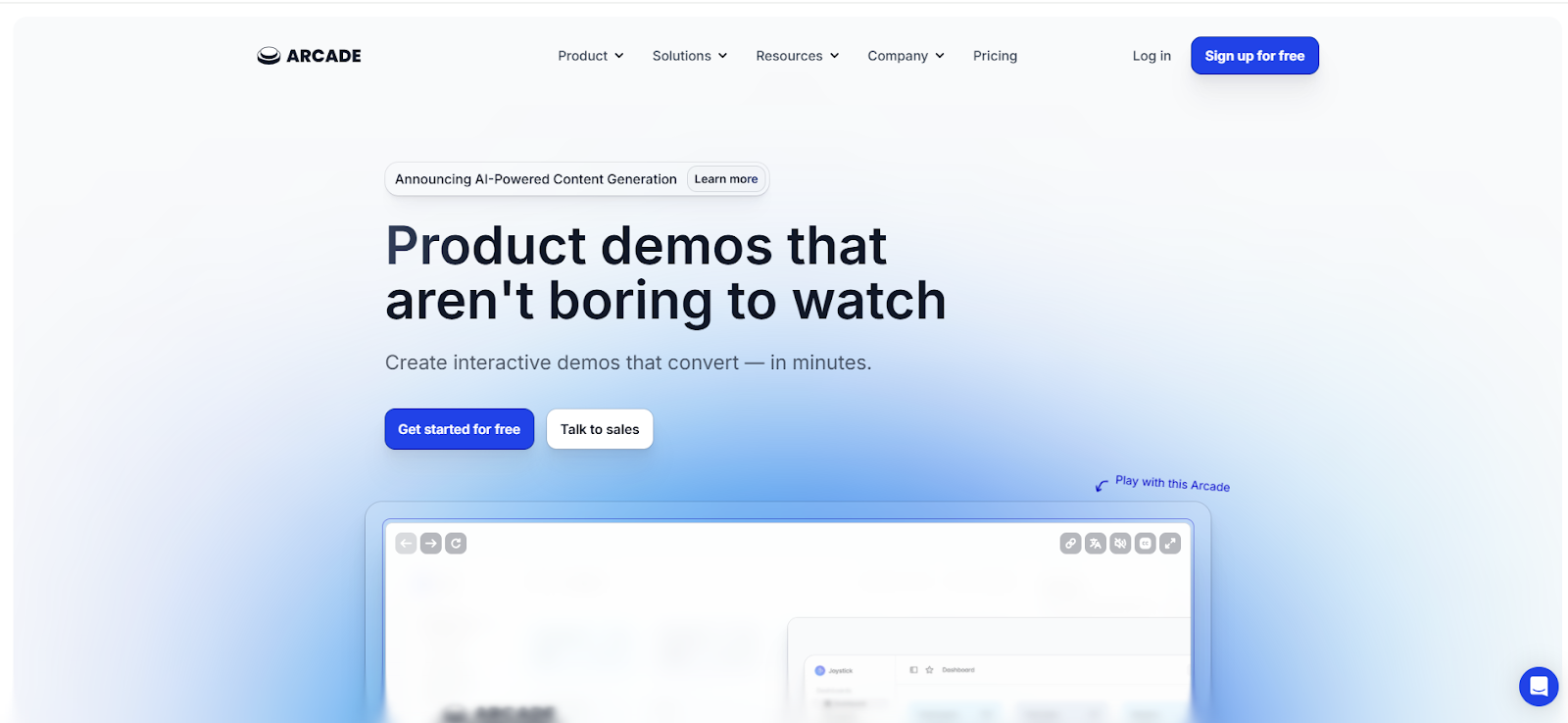
Arcade is an interactive product demo platform that is primarily designed for product managers, product marketers, and customer success professionals. The platform allows users to create lightweight interactive demos quickly and easily, with a median publish time under 10 minutes.
What are the best features of Arcade?
- AI Voiceovers: The platform lets you create AI-generated voiceovers using ElevenLabs integration with multiple languages and accents, including British accent, American accent to your product demos.
- Record your camera and screen: In addition to recording a step-by-step interactive demo, you can record your screen, webcam, or both and add it to an existing interactive demo.
- Page morph: Users can edit text directly within recorded product screenshots without code, allowing customization of data, names, and content shown to viewers.
What are the pros and cons of Arcade?
✅Easy demo creation - Users report the platform makes it simple to create step-by-step product demonstrations without complex video production
✅Simple website integration - Can be easily embedded on websites with iframe without browser blocking issues
❌Limited free analytics - Users cannot see statistics in the free version, requiring paid plans for analytics access
❌Missing advanced features - Some users mention wanting additional features that would be helpful but aren't currently available
What is Arcade’s pricing?
- Free Plan
- Pro: $38/month
- Growth: $50/month
- Enterprise: Custom pricing
Compare Arcade alternatives
4. Walnut.io
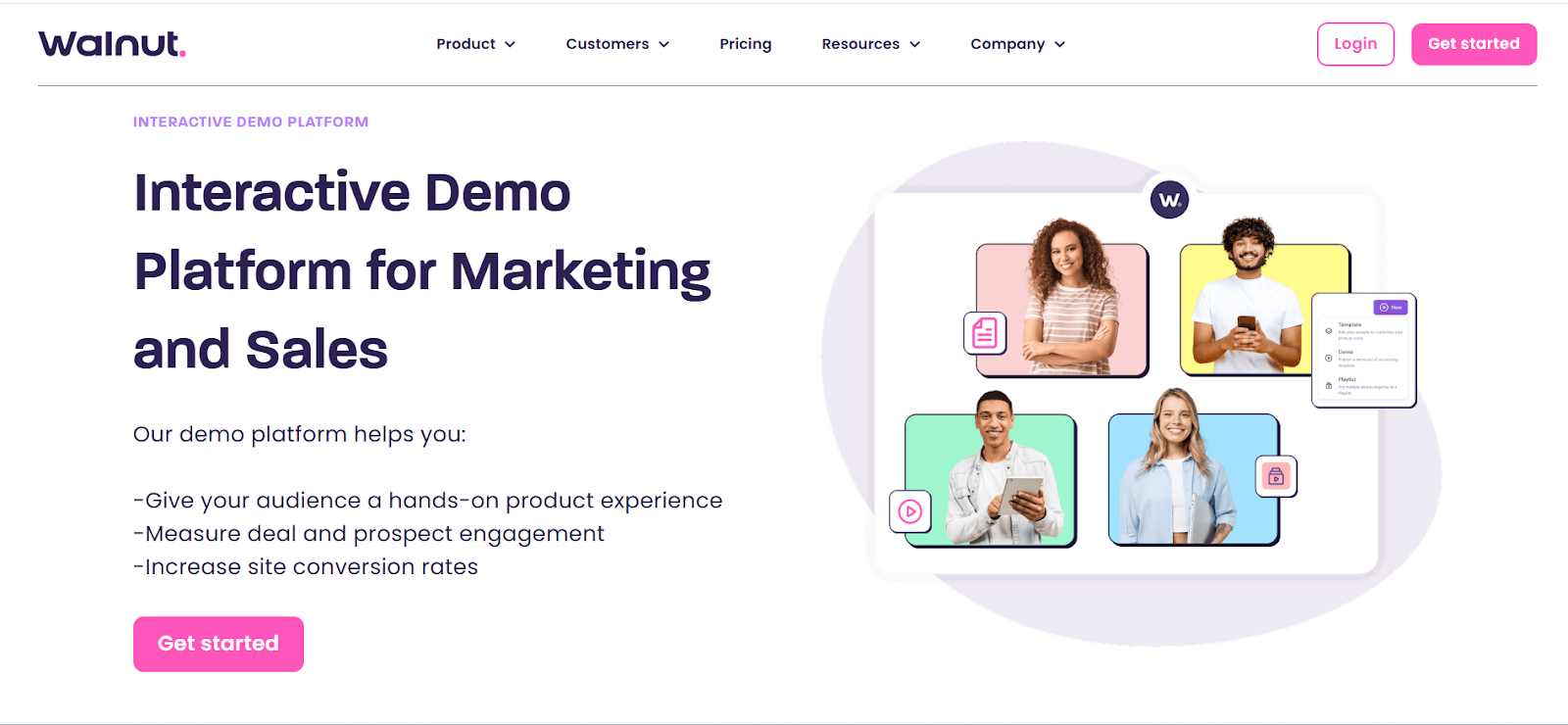
Walnut.io is an interactive demo platform for building HTML-based interactive product demos. The software helps you build demos for multiple use cases like live demonstrations, prospecting outreach, or demo onboarding.
What are the best features of Walnut.io?
- AI-powered content enhancement: The platform integrates with OpenAI to help users quickly enrich demo content, generate scripts, and provide assistance with demo-related questions and optimization.
- Multi-platform integration: The platform seamlessly integrates with CRM systems like Salesforce and HubSpot, collaboration tools like Slack and Trello, and marketing platforms like Marketo and Pardot
- Demo wizard: This feature helps users update prospects' information and content within the interactive demo, personalizing it for each viewer.
What are the pros and cons of Walnut.io?
✅Customizable demo personalization - Users appreciate the ability to customize and personalize demos for different audiences, allowing modification on the fly for specific prospects
✅No-code demo creation - Eliminates dependency on technical teams with codeless approach for personalizing sales demos
❌Steep learning curve - Users struggle with basic functionality that requires extensive customization and complex building experience
❌Confusing user interface - Navigation challenges hinder efficient workflow and prevent users from achieving desired results quickly
❌Performance issues - Frequent bugs, slow interaction speeds, login difficulties, and occasional lags during demo playback
What is Walnut.io's pricing?
- Lite: $9,200 annually
- Pro: $20,000 annually
- Enterprise: Custom pricing
Compare Walnut.io alternatives
5. Storylane
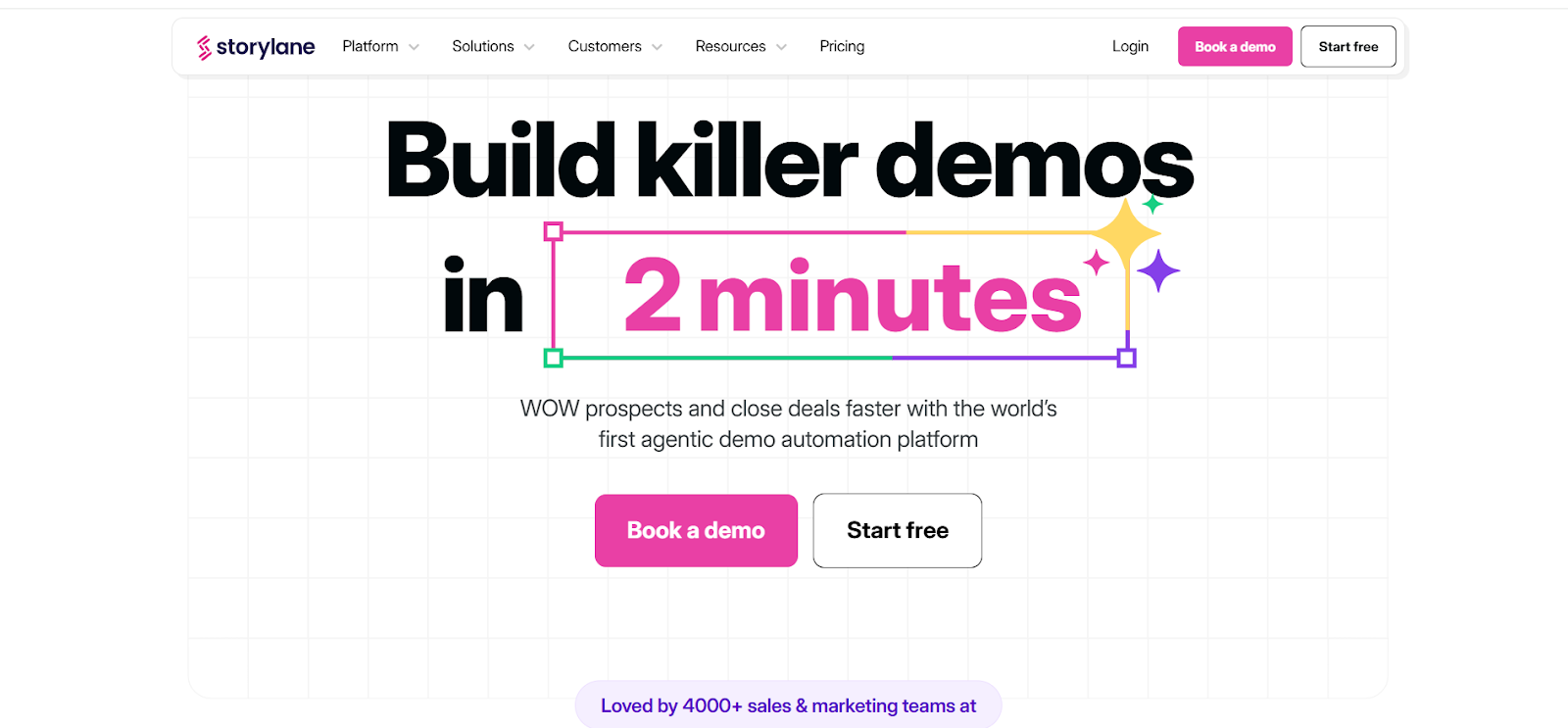
Storylane is one of the popular demo automation platforms, designed to help businesses create interactive product demos quickly and efficiently. The platform primarily helps marketing and sales teams build personalized, engaging product experiences to drive adoption, simplify enablement, and close deals.
What are the best features of Storylane?
- HTML demo capture: The platform captures your product's HTML and CSS to create clickable, interactive demos that replicate the actual look and feel of your product without requiring any coding skills
- Demo hub collections: Users can create centralized galleries and playlists of multiple demos, PDFs, and videos, allowing prospects to choose their own adventure based on persona or use case
- Lily AI: Storylane offers Lily AI that allows users to add AI voiceovers, personalize text captions, and optimize interactive demos with generative AI insights and recommendations.
What are the pros and cons of Storylane?
✅Lightweight and intuitive - Platform is user-friendly and requires minimal onboarding to start building and creating content
✅Multiple demo formats - Platform supports HTML capture, screenshot tours, and video walkthroughs, giving users flexibility in demo creation approaches
❌Export restrictions - Only supports individual demo tour exports, making bulk overview downloads inconvenient for large demo libraries
❌HTML capture bugs - Capture functionality can be buggy depending on the complexity of underlying software being captured.
❌Limited screen management - Users express difficulty duplicating screens between different demos, requiring recreation of similar content repeatedly.
What is Storylane’s pricing?
- Free: $0/month
- Starter: $40/month
- Growth: $500/month
- Premium: $1,200/month
- Enterprise: Custom pricing
Compare Storylane alternatives
6. Tourial
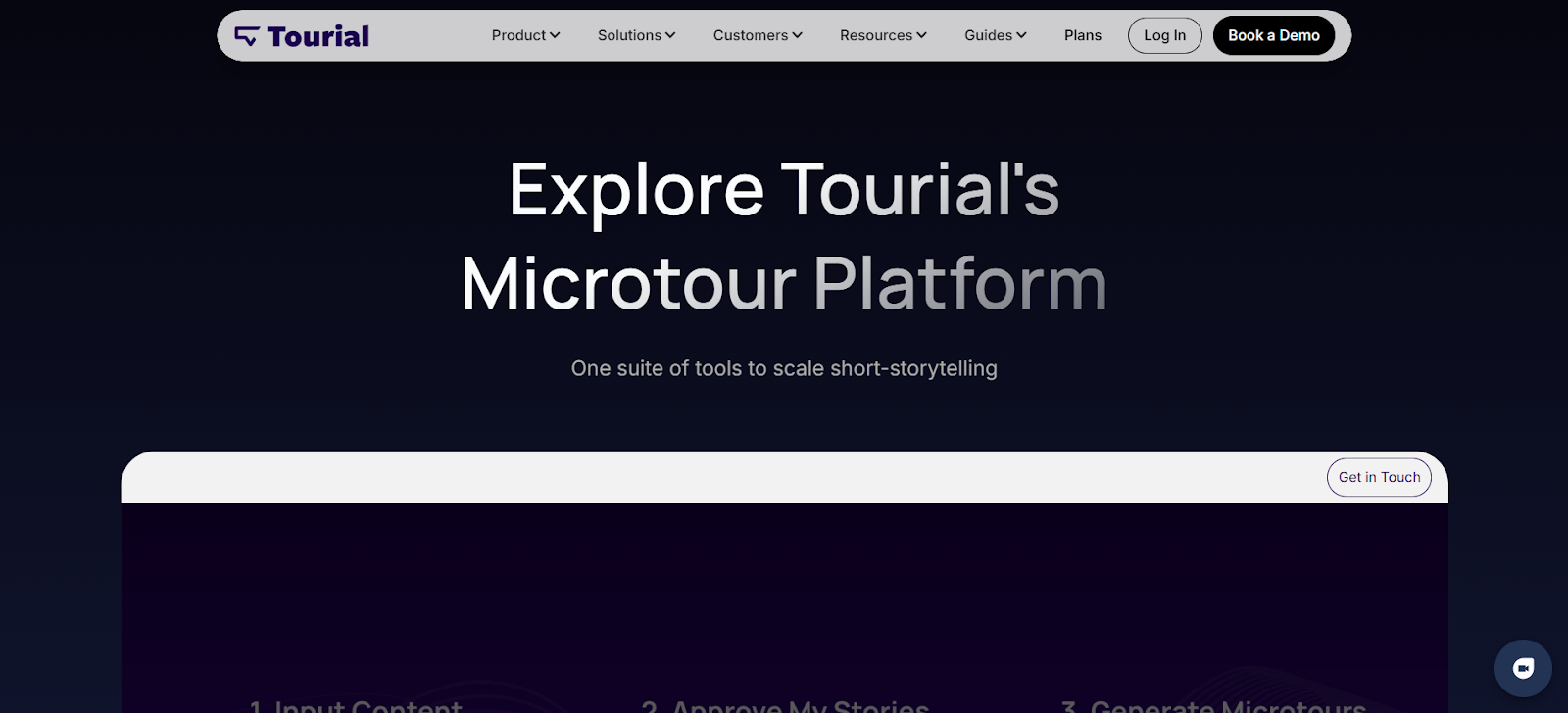
Tourial is an enterprise-focused interactive demo platform that lets users create self-guided demos in both HTML and media (screenshots and video) based format. These demos can be personalized at scale and consolidated into "demo centers" for streamlined sharing.
What are the best features of Tourial?
- AI-driven demo creation: Tourial offers AI-powered features for automated demo building, intelligent navigation, and content optimization to streamline the demo creation process
- Micro Tours: Users can create short, focused demos targeting specific features or use cases, allowing for targeted engagement without overwhelming prospects with comprehensive product overviews
- Customizable branding: Users can replace images, data, text, and logos throughout their demos to match company branding, with bulk change capabilities that apply modifications across entire demo environments at once
What are the pros and cons of Tourial?
✅Exceptional post-sales support - Dedicated CSM team provides strategic guidance and best practices optimization beyond basic support
✅Comprehensive marketing integrations - Seamless connectivity with HubSpot and Marketo, including robust engagement tracking capabilities
❌Pricing transparency issues - The platform doesn’t reveal its pricing plans
❌Subpar UX design - Users express dissatisfaction with the overall user experience and interface design quality
What is Tourial’s pricing?
- Tourial offers two plans: Engage and Scale. The pricing structure has not been disclosed publicly.
Compare Tourial alternatives
7. Demoboost
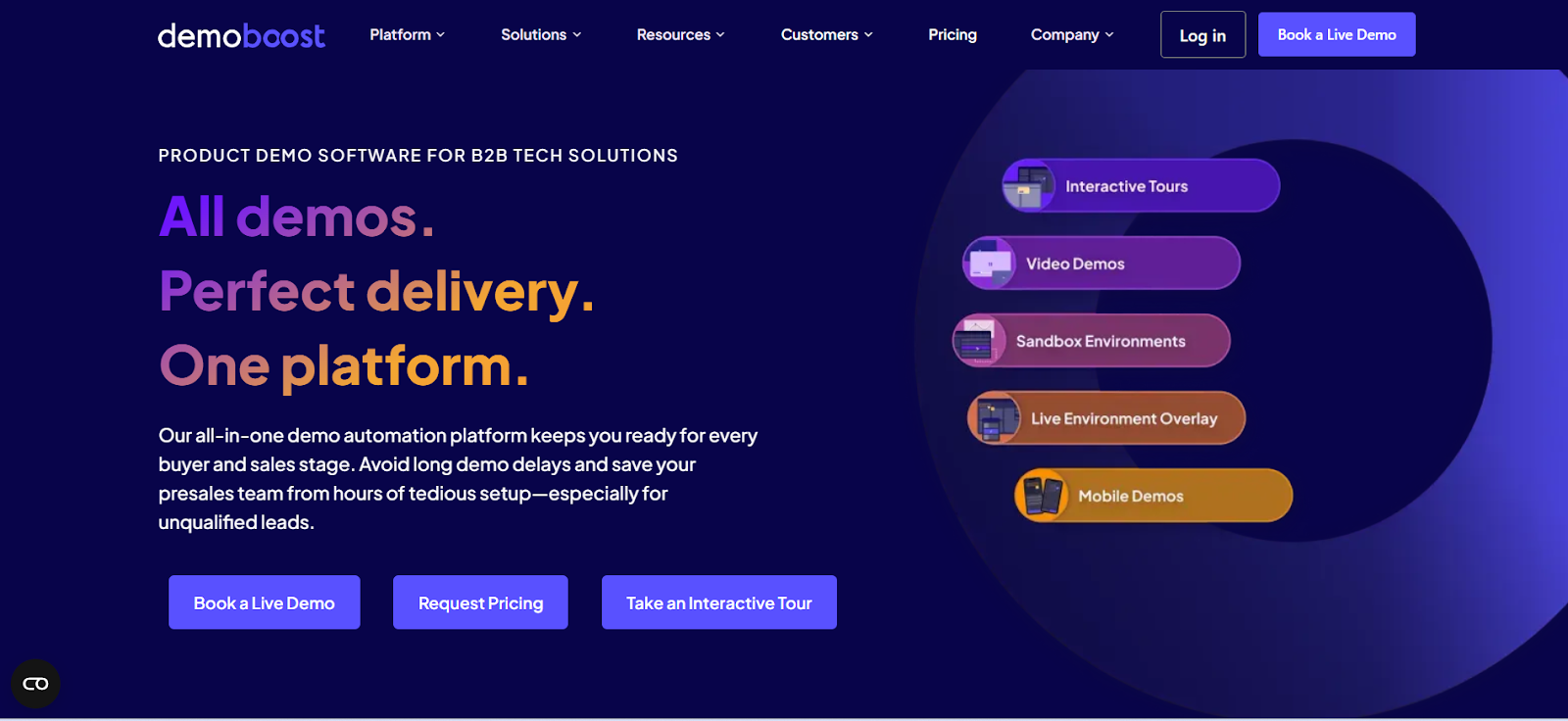
Demoboost is an enterprise-level demo platform designed for both marketing and pre-sales demonstrations. The platform has unique capabilities such as video overlays on HTML-based demos, internal feedback systems, and A/B testing functionality.
What are the best features of Demoboost?
- Dual demo modes: Users can instantly transform guided tours into live demo mode by enabling speaker notes, activity tracking, and disabling guides, allowing sales reps to run both self-serve and live demonstrations from the same content
- Internal collaboration tools: Teams can work together within the demo environment itself, adding comments and rich media elements like images and videos to enhance demonstrations.
- Auto-translation capabilities: The platform supports automatic translation of screens, guides, and speaker notes into 132 languages with one-click functionality for global demo deployment
What are the pros and cons of Demoboost?
✅Easy personalization - Platform allows easy tailoring of demos to specific client needs without requiring coding knowledge or presales technical skills
✅Strong analytics and tracking - Platform provides reliable analytics for real-time tracking of client interactions with detailed engagement data and conversion metrics
❌Slow performance issues - Users report performance limitations and time-consuming setup processes that impact team productivity
❌Missing feature gaps - Platform lacks certain functionality that teams expect, requiring workarounds for complete demo workflows
❌Vendor lock-in - High costs with lengthy contract lock-in periods and no free trial option forcing financial commitment before testing
What is Demoboost’s pricing?
- Demoboost operates on a custom pricing model without public rates. The platform requires direct contact with their sales team for pricing details.
Compare Demoboost alternatives
8. Consensus
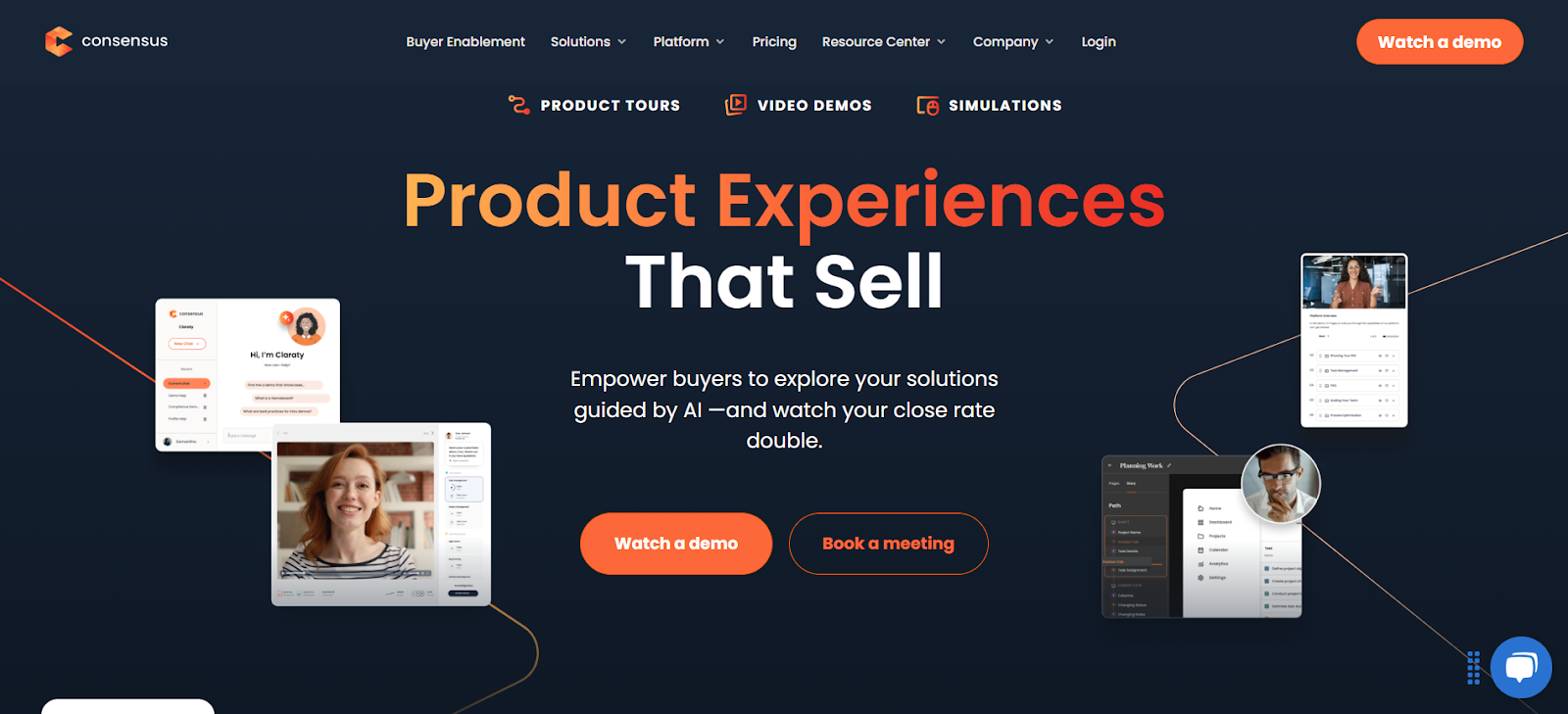
Consensus is a leading demo automation and product experience platform that empowers revenue teams to create, share, and track interactive product demos. It allows users to create interactive, on-demand video demos that personalize the buying experience without requiring live meetings.
What are the best features of Consensus?
- Product simulations: Build a sandbox environment without engineering help and offer a strings-free alternative to explore your tool’s features.
- Demolytics: Track how potential buyers engage with interactive walkthroughs through heatmaps and get stakeholder insights like demos sent, views, and completion rate.
- BuyerBoard: Build a central digital space with shareable demos, documentation and other resources to help buyers engage stakeholders and colleagues
What are the pros and cons of Consensus?
✅Easy demo personalization - Simple customization of demos with personalized video additions for prospects
✅Strong gmail integration - Seamless integration makes content sharing with customers effortless
❌Technical integration issues - Users report being promised HubSpot integration that doesn't actually exist, requiring additional paid third-party integration software
❌Limited customization options - The platform only allows color theme selection without options to change fonts or modify other text elements
❌Poor customer support - Users experience long resolution times for technical issues and unresponsive support during problem-solving
What is Consensus’s pricing?
- Consensus offers custom pricing plans.
Compare Consensus alternatives
9. Reprise
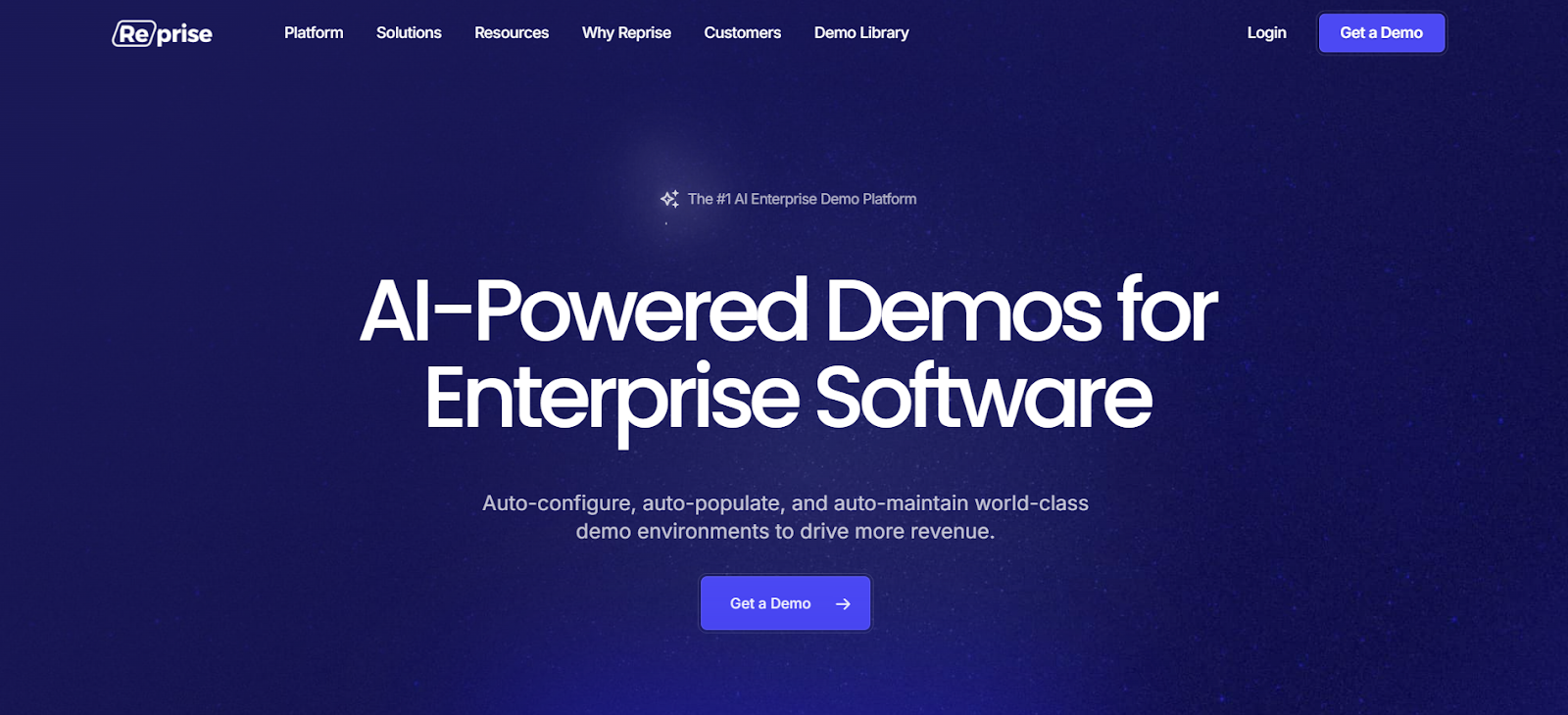
Reprise is an enterprise demo platform that creates interactive product demonstrations for sales, presales, and marketing teams. The platform captures your product's front-end and recreates it in a controlled environment, ensuring consistent demo performance without relying on live systems.
What are the best features of Reprise?
- Reprise replay: The platform captures web-based application front-ends with single-click, allowing users to customize everything including HTML code to build interactive product tours and shareable demos with unlimited editing flexibility.
- Full control over HTML/CSS editing: In addition to modifying text and images, you can fully control and personalize the demo experience by changing the front-end code of a recorded demo.
- Reprise reveal: Users can overlay and customize live applications in real-time through a browser extension, enabling presales teams to inject demo data, replace images and text, and apply bulk changes without coding requirements.
What are the pros and cons of Reprise?
✅Comprehensive analytics - Detailed tracking of demo performance including individual user engagement, screen viewing time, and drop-off points
✅Plugin extensibility - Infinite extensibility through plugin library including AI chatbot, automatic translation, and advanced customization features
❌Steep learning curve - Advanced features require significant technical knowledge that may overwhelm typical business users
❌Limited public information - Pricing and detailed feature information not readily available, requiring sales contact for evaluation
❌Non-intuitive interface - Tool lacks intuitive design making it difficult for average sales and marketing personnel to navigate
What is Reprise’s pricing?
- Reprise operates on a custom pricing model without public rates or free trials.
Compare Reprise alternatives
10. Demostack
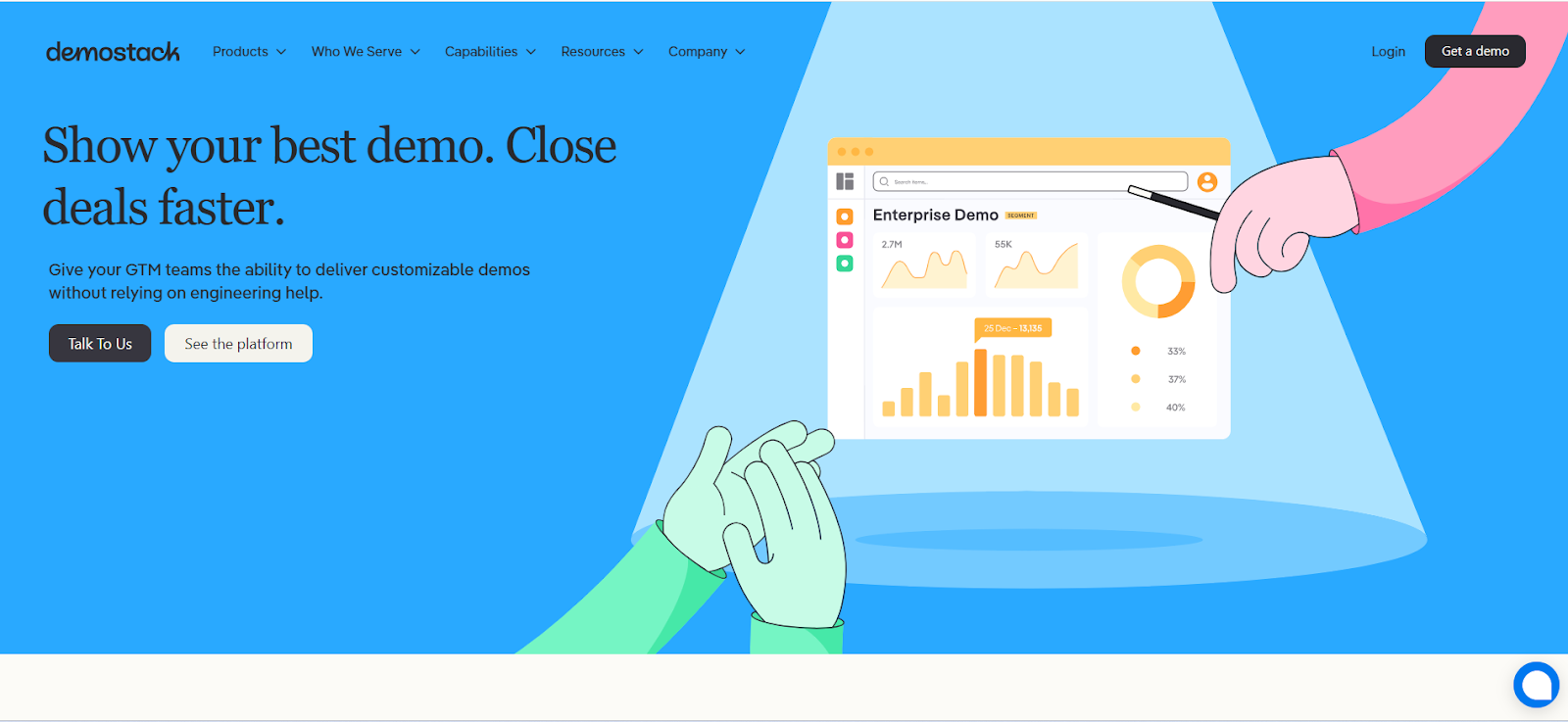
Demostack is one of the leading demo automation platforms that helps you build interactive product demos, live demos, mobile app demos, and sandbox product environments.
What are the best features of Demostack?
- Product cloning technology: Automatically replicates your entire product environment, creating pixel-perfect demos that stay in sync with your latest product updates and features.
- Cross-platform demo environments: Users can create demonstrations that work across web and mobile applications from a single interface, providing unified product experiences without device switching.
- Demo Playbooks: The platform bundles demos, slide decks, case studies, and product tours into organized playbooks accessible by use case, persona, industry, or partner for streamlined presentation delivery.
What are the pros and cons of Demostack?
✅Authentic demo experience - Platform creates demo environments that are almost identical to the original product
✅User-friendly interface - Intuitive platform design allows users to create interactive tours and demo environments quickly with high quality results
❌Limited deep testing capability - Platform struggles with complex testing scenarios and lacks capability for detailed product evaluation requirements
❌Ongoing maintenance requirements - Any product updates require recreating all existing clones from scratch since the platform captures products at specific moments in time
❌Demo URL instability - URLs change whenever demos are edited, creating difficulties when updating links across multiple marketing resources and materials
What is Demostack’s pricing?
- Demostack doesn't offer a free trial.
- Demostack's pricing is a per-user based pricing model and their price starts at $55,000 per year.
Compare Demostack alternatives
Top 4 use cases of interactive demo
Now that you've seen the top interactive demo software, you're probably wondering how to get started and what type of demos to create for your specific needs.
In this section, we've outlined the four popular interactive demo use cases: sales prospecting, customer success, marketing, and product onboarding.
Sales & enablement
Your sales teams can leverage interactive demos to accelerate deal velocity and improve conversion rates. Here’s how:
- Email outreach: Rather than just describing what your product does you can embed interactive product demos in your email outreach. This will pique their curiosity to engage with your cold email and boost chances of their conversion.
- Post-demo call sales collateral: After a sales call, your team can share an HTML or Sandbox demo with your prospects or champions. This enables them to clearly show your product's value and get buy-in from stakeholders who weren't present during the original demo.
Marketing and growth
Your marketing team can use the interactive demo software to generate demand and nurture leads throughout the buyer's journey.
- Product tours on website: You can create and embed interactive product tours to let your visitors experience your product’s "aha moments" firsthand. Gartner research shows that companies using interactive demos see 10x more MQL conversions and 450% more free trial sign-ups.
- Interactive product updates: You can embed interactive demos within product updates, changelogs, and release notes to help existing users quickly understand new capabilities. Users can immediately test functionality and see practical applications for their workflows rather than just reading feature descriptions.
Customer success
By using interactive demos, your customer success team can reduce repetitive support tickets by large and improve customer retention.
- Self-serve demos: Replace lengthy help articles with interactive demos for common tasks like report generation, user management, or data exports. Customers can practice the exact clicks and see real results instead of deciphering 15-step text instructions. This eliminates back-and-forth support conversations and frees up your team to focus on strategic account growth.
- Measure customer engagement: Interactive product demo creation platforms like Supademo offer built-in analytics to track your demo engagement. You can use these metrics to catch churn risks early. When customers stop exploring new features or repeatedly view basic setup demos, you can intervene with targeted training before they become frustrated and leave.
Product onboarding
Your product team can create seamless onboarding experiences that turns them into confident power users from day one.
- Create in-app tours: Build interactive tours that let new users complete actual workflows with sample data—like creating their first dashboard, setting up integrations, or configuring team permissions. Users learn by doing rather than watching, so they understand your product's value before touching their real data.
- Role-based onboarding paths: You can create different demo sequences for different user personas (admin, end-user, analyst). Each user sees features most relevant to their role from day one, reducing time-to-value and improving long-term retention.
| Choose the Right Interactive Demo Tool for Your Use Case | |
|---|---|
Use case | Interactive demo software |
Sales enablement | Supademo, Storylane, Arcade |
Product marketing and growth | Supademo, Navattic, Tourial |
Customer success | Supademo, Demostack, Reprise |
Product onboarding | Supademo, Walnut.io, Demoboost, Consensus |
How to choose interactive demo software?
The interactive demo market has exploded in recent years, giving you more options than ever, but also making the choice more complex.
While you have more options than ever, the quality and capabilities vary dramatically between vendors. Making the wrong choice can lead to low team adoption, missed revenue opportunities, and the need to switch platforms later.
To help you find the right fit for your organization, we’ve listed 7 key factors to consider before choosing the right interactive demo platform:
Ease of use
Your platform needs to work for everyone on your team, not just your most technical users.
Look for an interactive demo builder with an intuitive drag-and-drop interface that allows marketing managers, sales reps, and customer success professionals to create compelling demos without engineering support.
Similarly, for your customer,s the platform should provide intuitive navigation. This reduces frustration and keeps the viewers engaged.
Demo types and flexibility
Choose software that supports multiple creation methods to match different use cases. Look for platforms that offer:
- Screenshot-based and video demos for quick creation
- HTML capture for pixel-perfect accuracy that preserves your actual product interface
- Sandbox demos that allow prospects to interact with live functionality without affecting your production environment.
This flexibility matters because your demo needs will evolve. Today you might need simple product tours for your website, but next quarter you could be creating interactive onboarding sequences and sales presentations.
Personalization features
The best demos tell a story that matches your customer's specific needs. Choose software that lets you create different scenarios based on industry, company size, or specific challenges.
Personalization features should include dynamic variables for names and company information, customizable demo flows, and the ability to create templates that can be quickly adapted for different prospects. Personalized demos make prospects feel understood and show how your product solves their unique problems.
Interactive elements and AI assistance
Look for software that lets customers click, explore, and test your product themselves. Good interactive demos convert more leads because prospects can experience your product's benefits firsthand rather than just hearing about them.
AI features should reduce manual work—like automatically generating step descriptions, creating realistic demo data, and suggesting optimization improvements. But make sure these features integrate naturally into your workflow rather than adding complexity.
Embed and share options
Distribution is often an afterthought during evaluation, but it's where many tools fall short in real-world usage. Your demo software should work across all your marketing, sales, and training channels.
Your prospects and customers should be able to access the demos easily from your website, share via email, or link from social media.
Plus, look for built-in lead capture forms that help you collect visitor information. This will help you identify anonymous visitors and personalize outreach.
Analytics and insights
Evaluate your platform based on this key question: Does the platform help you understand not just how many people viewed your demo, but which parts resonated and what actions to take next?
Your interactive product demo platform should provide a clear view of which features interest users most, how long they engage, and where they drop off.
These insights are key for improving your demos and your product.
Integration with your tech stack
Select a solution that connects natively with your existing CRM, marketing automation, and analytics tools. Demo engagement data should flow seamlessly into your prospect records, trigger automated follow-up workflows, and enhance your existing sales intelligence.
Looking for an interactive demo software that checks all these boxes?
Supademo could be an ideal solution for you.
Build your first interactive demo with Supademo
Supademo offers a comprehensive range of features— synthetic AI voice-overs, HTML capture, sandbox demos, video integration, and robust editing tools like zoom and pan. The deep customization options, including dynamic variables and conditional branching, help your team create interactive demos faster that deliver exactly what prospects need to see.
You can share demos with personalized links and track who engages, which features they explore, and where they drop off.
Whether you're a startup looking to quickly demonstrate product value, an SMB scaling your sales process, or an enterprise needing demos across multiple teams, Supademo provides the right tools to create interactive product demos at scale.
The best part? You can sign up for Supademo completely free with no commitments.
Ready to build your first interactive demo? Try Supademo today
FAQs
What are interactive demos?
Interactive demos are clickable product walkthroughs that let prospects explore your software without signing up.
Unlike static videos or presentations, they put users in control to click buttons, navigate menus, and experience real results. They're "try before you buy" experiences that showcase how your product solves specific problems.
What is Supademo?
Supademo is a no-code interactive demo platform designed for sales, marketing, and customer success teams. It enables users to create engaging product demonstrations using Chrome extension, desktop app, or mobile recording.
Features include AI assistance, HTML capture, analytics, personalization, and integrations with CRM systems like HubSpot and Salesforce.
How to create a clickable demo?
Use interactive demo software like Supademo to capture your product's interface through HTML capture or screenshot methods. Add clickable hotspots, customize navigation paths, and include personalized elements like dynamic variables. Most platforms offer drag-and-drop editors that require no coding skills, letting you build professional demos in minutes.
How do I make my demo more interactive?
Start with personalization—customize content for specific user personas and use dynamic variables for names/companies. Ensure easy navigation with clear pathways and intuitive flow. Add interactive elements like clickable hotspots, conditional branching, AI voiceovers, and sandbox functionality for hands-on exploration.
What are the three types of interactive demos?
The types of interactive demos are: Screenshot-based demos for quick creation using static images with hotspots; HTML capture demos that replicate your actual product interface with pixel-perfect accuracy; and Sandbox demos that allow prospects to interact with live functionality in a controlled environment without affecting production systems.













.webp)






.png)









